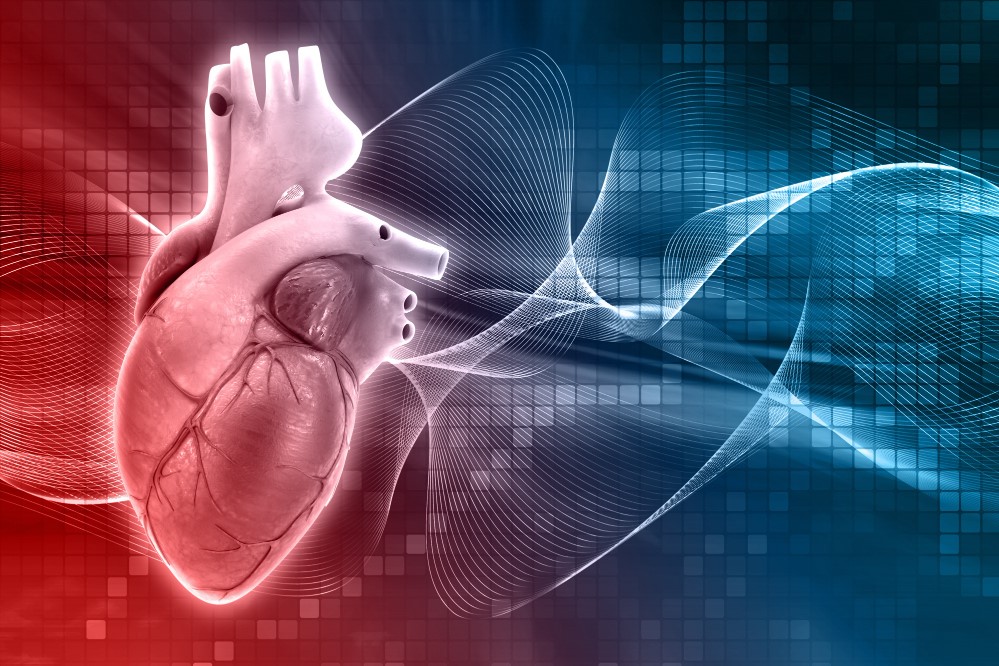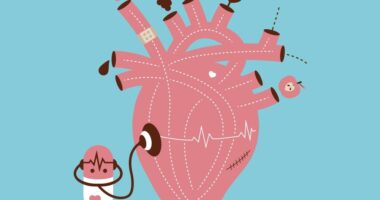Cardiomyopathy is a progressive condition affecting the heart muscle, known as the myocardium. Over time, the myocardium weakens, leading to decreased efficiency in pumping blood throughout the body.
There are various forms of cardiomyopathy, each with its own underlying causes. These causes range from coronary heart disease to the use of certain medications. If left untreated, cardiomyopathy can result in complications such as irregular heart rhythms, heart failure, or other related issues.
It is crucial to seek medical attention and adhere to follow-up care to prevent the progression of heart failure or damage.
This article will provide a comprehensive overview of the different types of cardiomyopathy, their associated symptoms, underlying causes, and available treatment options.
What are the Types of Cardiomyopathy?
Cardiomyopathy encompasses four primary types:
- Dilated cardiomyopathy, also known as an “enlarged heart,” occurs when the heart muscle expands or dilates, resulting in reduced efficiency in pumping blood. It can be inherited or a consequence of coronary artery disease. This type of cardiomyopathy is the most prevalent.
- Hypertrophic cardiomyopathy involves the thickening of the heart walls, impeding the flow of blood through the heart. It is commonly attributed to genetic factors. However, acquired forms can be caused by long-term high blood pressure, aging, diabetes, or thyroid disease. In certain cases, the underlying cause remains unidentified.
- Arrhythmogenic right ventricular dysplasia (ARVD) is an exceedingly rare form of cardiomyopathy but is the primary cause of sudden death among young athletes. This genetic cardiomyopathy is characterized by the replacement of muscle in the right ventricle with additional fibrous tissue and fat. It leads to abnormal heart rhythms and dysfunction in the right ventricle.
- Restrictive cardiomyopathy occurs when the ventricles of the heart become stiff and cannot relax adequately to fill with blood. Possible causes include heart disease, cardiac scarring, and cardiac amyloidosis, which often occurs following a heart transplant.
These four types of cardiomyopathy encompass a range of causes, symptoms, and complications, highlighting the importance of understanding each variant for accurate diagnosis and appropriate treatment.
Other Types of Cardiomyopathy
Several types of cardiomyopathy exist that may fall under the previously mentioned classifications, each with distinct causes and complications:
- Peripartum cardiomyopathy: This rare type occurs during or after pregnancy when the heart weakens within five months of delivery or in the final month of pregnancy. It is a form of dilated cardiomyopathy and poses a life-threatening risk. It is sometimes referred to as postpartum cardiomyopathy, and having it once increases the risk in subsequent pregnancies.
- Alcoholic cardiomyopathy: Prolonged and excessive alcohol consumption can weaken the heart muscle, impairing its ability to pump blood efficiently. It can also lead to an enlarged heart. Alcoholic cardiomyopathy belongs to the category of dilated cardiomyopathy.
- Ischemic cardiomyopathy: This type occurs when coronary artery disease prevents the heart from effectively pumping blood to the rest of the body. Narrowed and blocked blood vessels in the heart impede oxygen delivery to the heart muscle. Ischemic cardiomyopathy is a common cause of heart failure. On the other hand, nonischemic cardiomyopathy refers to any form of the condition unrelated to coronary artery disease.
- Noncompaction cardiomyopathy: Also known as spongiform cardiomyopathy, this rare condition is present at birth and arises from abnormal development of the heart muscle in the womb. It can be diagnosed at any stage of life.
- Paediatric cardiomyopathy: When cardiomyopathy affects children, it is referred to as paediatric cardiomyopathy.
- Idiopathic cardiomyopathy: Idiopathic cardiomyopathy refers to cases where the cause is unknown.
Understanding these additional types of cardiomyopathy is vital for accurate diagnosis, appropriate management, and improved outcomes for patients.

What are The Symptoms of Cardiomyopathy?
The symptoms associated with all forms of cardiomyopathy are typically similar. In each case, the heart is unable to effectively pump blood to the body’s tissues and organs, leading to the following symptoms:
- General weakness and fatigue
- Shortness of breath, especially during physical activity or exercise
- Feelings of lightheadedness or dizziness
- Chest pain
- Heart palpitations
- Episodes of fainting
- High blood pressure
- Abdominal bloating
- Coughing while lying down
- Edema, which involves swelling in the feet, ankles, legs, or other body parts
Recognizing these common symptoms is crucial for early detection and appropriate management of cardiomyopathy, regardless of its specific type. If you experience any of these symptoms, it is important to seek medical attention promptly.
What Causes Cardiomyopathy?
As per information from the National Heart, Lung, and Blood Institute, the cause of cardiomyopathy often remains unidentified. However, in some cases, it can be attributed to either inherited or acquired factors:
- Inherited: This means that cardiomyopathy is present from birth due to specific genes inherited from parents.
- Acquired: Cardiomyopathy can develop during one’s lifetime as a result of various health conditions, diseases, or other illnesses, such as:
- Coronary artery disease
- Heart tissue damage resulting from a heart attack
- Infections affecting the heart muscle
These causes highlight the diverse nature of cardiomyopathy and the importance of considering both genetic and acquired factors when diagnosing and managing the condition.
Risk Factors for Cardiomyopathy
Cardiomyopathy can affect individuals of all age groups, and several significant risk factors are associated with its development. These risk factors include:
- Family history of cardiomyopathy, sudden cardiac arrest, or heart failure
- Coronary artery disease
- Chronic (long-term) high blood pressure
- Heart damage resulting from a heart attack
- Infections leading to inflammation of the heart
- Heart valve disorders
- COVID-19 infection
- Diabetes
- Obesity
- Thyroid disease
- Alcohol use disorder
- Sarcoidosis
- Hemochromatosis
- Amyloidosis
- Connective tissue disorders
- Use of cocaine or amphetamines
- Certain cancer medications
- Exposure to toxins such as poison or heavy metals
Furthermore, according to research conducted in 2016, HIV infection and its treatments can increase the risk of cardiomyopathy, particularly heart failure and dilated cardiomyopathy. Individuals with HIV are advised to discuss regular heart health tests with their healthcare provider and adopt a heart-healthy diet and exercise program.
By understanding these risk factors and implementing appropriate preventive measures, individuals can take proactive steps to maintain their heart health, especially in the presence of underlying conditions or lifestyle factors that may contribute to cardiomyopathy.
When to See a Doctor
While some individuals with cardiomyopathy may not experience any symptoms, many people do develop warning signs that indicate a weakening of the heart. If you observe any of the following symptoms, it is crucial to contact your doctor promptly:
- Shortness of breath
- Unusual or new fatigue
- Swelling in the abdomen, legs, feet, ankles, or neck
- Chest pain, particularly after physical exertion or large meals
- Fainting during exercise or physical exertion
- Irregular heartbeat (arrhythmia)
If your doctor suspects a heart-related condition, they may refer you to a cardiologist. A cardiologist specializes in diagnosing and treating heart conditions and can provide specialized care based on your individual needs. Seeking timely medical attention and appropriate specialist care is essential for the management and treatment of cardiomyopathy.
How is Cardiomyopathy Diagnosed?
To make a diagnosis of cardiomyopathy, your doctor or cardiologist will consider four key components:
- Personal and family medical history: Your doctor will review your medical history, including any symptoms you have experienced and any family history of cardiomyopathy or related conditions.
- Physical examination: A thorough physical examination will be conducted, which may involve listening to your heart, checking for signs of fluid retention, and assessing other relevant indicators.
- Diagnostic tests and procedures: Various tests and procedures may be used to aid in the diagnosis of cardiomyopathy, including:
– Blood tests: These tests can provide information about your heart function and help rule out other conditions.
– Chest X-ray: This imaging test allows your doctor to visualize the size and structure of your heart and check for any signs of fluid accumulation.
– Stress test: A stress test assesses how your heart functions during physical exertion.
– Electrocardiogram (EKG or ECG): This test records your heart’s electrical activity over a short period to evaluate its rhythm and any abnormalities.
– Holter monitor: A Holter monitor or event monitor records your heart’s electrical activity over 24 or 48 hours to detect irregularities.
– Echocardiogram: This non-invasive test uses sound waves to create real-time images of your heart, providing information about its structure and function.
– Heart MRI: Magnetic resonance imaging (MRI) uses magnets and radio waves to produce detailed images of your heart and coronary blood vessels.
4. Additional diagnostic procedures: In some cases, your doctor may perform additional procedures to confirm the diagnosis, especially if you are planning to undergo surgery. These may include:
– Cardiac catheterization: This procedure involves inserting a thin tube into an artery or vein and guiding it to the heart to assess various aspects, such as the presence of artery blockages.
– Coronary angiography: Dye is injected into your bloodstream to visualize blood flow through your arteries and heart.
– Myocardial biopsy: A small sample of heart tissue is taken for microscopic examination, typically to evaluate the presence of specific abnormalities.
By considering these components and conducting appropriate tests and procedures, your doctor can make an accurate diagnosis of cardiomyopathy, allowing for the implementation of an appropriate treatment plan.
How is Cardiomyopathy Treated?
The treatment approach for cardiomyopathy depends on the extent of heart damage and the presence of symptoms. While cardiomyopathy cannot be reversed or cured, it can be effectively managed through various treatment options. These include:
- Heart-healthy lifestyle changes: Adopting a heart-healthy lifestyle can significantly benefit individuals with cardiomyopathy. This involves maintaining a moderate weight, quitting smoking, following a balanced and nutritious diet, managing stress, and engaging in appropriate levels of physical activity.
- Medications: Several medications may be prescribed to manage cardiomyopathy and its associated symptoms. These medications can include those used to treat high blood pressure, prevent water retention, maintain a normal heart rhythm, prevent blood clots, and reduce inflammation.
- Surgically implanted devices: In some cases, surgically implanted devices such as pacemakers or defibrillators may be recommended to regulate the heart’s rhythm or provide electrical stimulation when necessary.
- Surgery: If symptoms are severe and medication management is not sufficient, surgery may be an option. Procedures like bypass surgery or valve surgery can be considered to improve blood flow and alleviate symptoms. In rare cases, a septal myectomy procedure, which involves the removal of a portion of heart tissue, may be performed to enhance blood flow.
- Heart transplant: In severe cases where other treatment options have been exhausted or are ineffective, a heart transplant may be considered as a last resort. This involves replacing the damaged heart with a healthy donor heart.
The primary goal of treatment is to optimize heart function, alleviate symptoms, prevent further damage, and improve overall quality of life. Treatment plans are tailored to each individual based on their specific condition and needs, and regular monitoring and follow-up with healthcare professionals are essential for ongoing management and adjustments to the treatment approach.
Can Cardiomyopathy be Prevented?
To minimize the impact of cardiomyopathy, it is important to adopt a proactive approach in maintaining a healthy heart, whether or not there is a family history of the condition. Here are some steps you can take to lower your risk of developing cardiomyopathy:
- Regular exercise: Engage in regular physical activity and aim to incorporate at least 30 minutes of exercise most days of the week. Minimize sedentary behavior and prioritize an active lifestyle.
- Sufficient sleep: Prioritize getting an adequate amount of sleep, aiming for 7 to 8 hours each night. Poor sleep habits have been associated with an increased risk of heart disease.
- Heart-healthy diet: Adopt a balanced and nutritious diet that promotes heart health. Limit consumption of sugary, fried, fatty, and processed foods. Instead, focus on incorporating fruits, vegetables, whole grains, lean proteins, nuts, seeds, and low-fat dairy products. Be mindful of your salt (sodium) intake as excessive consumption can raise the risk of high blood pressure.
- Stress reduction: Find healthy ways to manage and reduce stress levels. Engage in activities such as regular brisk walks, deep breathing exercises, meditation, yoga, listening to music, or confiding in a trusted friend or counsellor.
- Smoking cessation: If you smoke, quitting smoking is crucial. Smoking adversely affects the cardiovascular system, including the heart, blood, and blood vessels. Seek support and resources to help you quit smoking.
- Management of underlying health conditions: If you have any underlying health conditions that may increase the risk of cardiomyopathy, work closely with your healthcare provider to control and manage them effectively. This may include conditions such as high blood pressure, diabetes, or thyroid disorders.
Remember that while these steps can help lower your risk, they do not guarantee complete prevention of cardiomyopathy. It is important to stay informed, maintain regular check-ups with your healthcare provider, and seek appropriate medical advice based on your individual circumstances.
What is the Long-Term Outlook?
Cardiomyopathy can be a life-threatening condition and its severity can impact life expectancy. Treatment plays a crucial role in managing the disease and slowing its progression. Along with medical interventions, making lifestyle changes is essential for improving heart health and prolonging heart function. Here are some important lifestyle changes to consider if you have cardiomyopathy:
- Heart-healthy diet: Adopting a heart-healthy diet can have a positive impact on your overall cardiovascular health. Focus on consuming a balanced diet rich in fruits, vegetables, whole grains, lean proteins, nuts, seeds, and low-fat dairy products. Limit your intake of saturated and trans fats, sodium (salt), added sugars, and processed foods.
- Moderate weight maintenance: Maintaining a moderate weight is beneficial for your heart health. Work with your healthcare provider or a registered dietitian to develop a weight management plan that suits your individual needs.
- Smoking cessation: Quitting smoking is crucial in managing cardiomyopathy. Smoking can further damage your heart and blood vessels, worsening the condition. Seek support and resources to help you quit smoking.
- Regular exercise: Engaging in regular exercise is important for overall cardiovascular fitness, weight management, and maintaining heart function. However, it’s crucial to consult with your doctor before starting or modifying an exercise program. They can recommend exercises that are safe and suitable for your specific condition, taking into account the type of cardiomyopathy you have. They can also provide guidance on monitoring signs and symptoms during exercise.
It’s important to remember that exercise should be tailored to your individual capabilities and limitations. Listen to your body, pace yourself, and don’t push beyond your comfort level. Regular check-ins with your healthcare provider are crucial to assess your progress and make any necessary adjustments to your exercise routine.
By implementing these lifestyle changes and working closely with your healthcare team, you can improve your heart health, manage your cardiomyopathy, and potentially prolong your life expectancy.
The Bottom Line
Cardiomyopathy is indeed a progressive disease characterized by the weakening of the heart muscle. As the heart muscle weakens, it becomes less effective at pumping blood throughout the body, leading to various symptoms and potential complications.
The causes of cardiomyopathy can vary, including coronary artery disease, heart attack, genetic factors, and other underlying health conditions. In some cases, the cause remains unknown.
Dilated cardiomyopathy and hypertrophic cardiomyopathy are two of the most common types of cardiomyopathy. Dilated cardiomyopathy is characterized by the enlargement and weakening of the heart chambers, while hypertrophic cardiomyopathy involves the thickening of the heart muscle.
Shortness of breath, fatigue, and swelling in the extremities and abdomen are common symptoms of cardiomyopathy. If you experience any of these symptoms, it is important to seek medical attention promptly. Early diagnosis and treatment can help manage the condition, reduce the risk of complications, and preserve heart function.
It is always recommended to consult with a healthcare professional for an accurate diagnosis and appropriate treatment options if you suspect you may have cardiomyopathy.









